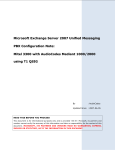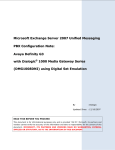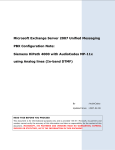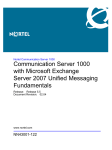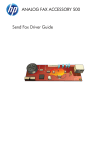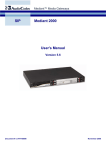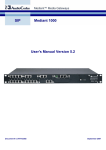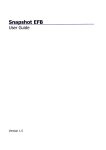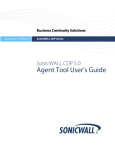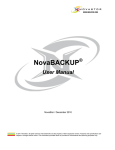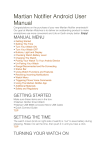Download Inter-Tel 5000 Configuration Note
Transcript
Microsoft Exchange Server 2007 Unified Messaging
PBX Configuration Note:
Inter-Tel 5000 with the Mediant 2000 Gateway using
T1-CAS (In-band DTMF)
By
: AudioCodes
Updated Since
: 2007-05-28
READ THIS BEFORE YOU PROCEED
This document is for informational purposes only and is provided “AS IS”. Microsoft and its partners cannot
verify the accuracy of this information and take no responsibility for the content of this document. To the
extent permitted by law, MICROSOFT MAKES NO WARRANTIES OF ANY KIND, DISCLAIMS ALL
EXPRESS, IMPLIED AND STATUTORY WARRANTIES, AND ASSUMES NO LIABILITY TO YOU FOR
ANY DAMAGES OF ANY TYPE IN CONNECTION WITH THE CONTENT OF THIS DOCUMENT.
1
Content
This document describes the configuration required to setup Inter-Tel 5000 and AudioCodes Mediant 2000
using T1 CAS with inband DTMF as the telephony signaling protocol. It also contains the results of the
interoperability testing of Microsoft Exchange 2007 Unified Messaging based on this setup.
Intended Audience
This document is intended for Systems Integrators with significant telephony knowledge.
Technical Support
The information contained within this document has been provided by Microsoft partners or equipment
manufacturers and is provided AS IS. This document contains information about how to modify the
configuration of your PBX or VoIP gateway. Improper configuration may result in the loss of service of the
PBX or gateway. Microsoft is unable to provide support or assistance with the configuration or
troubleshooting of components described within. Microsoft recommends readers to engage the service of a
Microsoft Exchange 2007 Unified Messaging Specialist or the manufacturers of the equipment(s) described
within to assist with the planning and deployment of Exchange Unified Messaging.
Microsoft Exchange 2007 Unified Messaging (UM) Specialists
These are Systems Integrators who have attended technical training on Exchange 2007 Unified Messaging
conducted by Microsoft Exchange Engineering Team. For contact information, visit here.
Version Information
Date of Modification
Details of Modification
4/6/2007
Initial pass for Inter-Tel configuration
2
1. Components Information
1.1. PBX or IP-PBX
PBX Vendor
Inter-Tel
Model
5000 series platforms
Software Version
Inter-Tel 5000 v2.1 and greater
Telephony Signaling
T1 CAS with in-band DTMF
Additional Notes
1.2. VoIP Gateway
Gateway Vendor
Audiocodes
Model
Mediant 2000
Software Version
4.80A.027.002
VoIP Protocol
SIP
1.3. Microsoft Exchange Server 2007 Unified Messaging
Version
RTM
2. Prerequisites
2.1. PBX Requisites
•
The Analog Voice Mail Hunt Group premium feature must be enabled in the Inter-Tel system.
•
The Inter-Tel 5000 doesn't support the sending of the calling user number for direct calls (i.e., the
user calls UM to retrieve voice message). Therefore, when the user dials directly to the Exchange
2007 UM Server, the user hears the general welcome prompt: “Welcome, you are connected to
Microsoft Exchange, to access your mailbox, enter your extension.”, at which the user is required to
enter the user's extension number in addition to the pin number.
2.2. Gateway Requisites
The gateway also supports TLS (in addition to TCP). This provides security by enabling the encryption of SIP
packets over the IP network. The gateway supports self-signed certificates as well as Microsoft Windows
Certificates Authority (CA) capabilities.
2.3. Cabling Requirements
This integration uses standard RJ-48c cables to connect digital trunks (T1/E1) between the PBX and Mediant
2000 trunk interfaces.
3
3. Summary and Limitations
A check in this box indicates the UM feature set is fully functional when using the PBX/gateway in
question.
•
Since this solution implements T1-CAS, the caller ID of the external caller to UM can't be sent by
the PBX. Therefore, the calling party ID is not part of the delivered message.
•
When using subscriber access, it's necessary to first enter the mailbox, and then the password.
4
4. Gateway Setup Notes
Step 1: SIP Environment Setup
5
Step 2: Routing Setup
Note: The Proxy IP Address must be one that corresponds to the network environment in which the
Microsoft Unified messaging server is installed (For example, 10.15.3.207 or the FQDN of the Microsoft
Unified messaging host).
6
Step 3: Coder Setup
7
Step 4: Digit Collection Setup
8
Step 5: Manipulation Routing Setup
There are two options to setup the Manipulation Routing:
•
For general deployments, use the manipulation routing setup as described in Step 5(a).
•
For Auto Attendant and Unified Messaging combined solution, use Step 5(a) or Step 5(b), which is
an example used for our specific testing environment.
Step 5 (a): Standard Manipulation Routing Setup
9
Step 5 (b): Manipulation Routing Example
In this example, the dial plan of the Inter-Tel system uses 12xx. The Source Prefix is the phone
number in the Trunk Group Settings step. In this example setup, 1790 is the Auto Attendant pilot
number of the Microsoft Unified Messaging Server. The configuration in this table resends inbound
calls destined for the Auto Attendant, to Microsoft Unified Messaging with the configured pilot number
for the Auto Attendant application.
10
Step 6: Trunk Group Setup
There are two options to setup the Trunk Group:
•
For general deployments, use the trunk group setup as described in Step 6(a).
•
For Auto Attendant and Unified Messaging combined solution, use Step 6(a) or Step 6(b), which is
an example used for our specific testing environment.
Step 6 (a): Standard Trunk Group Setup
11
Step 6 (b): Trunk Group Setup Example
This configuration represents a split T1 configuration where the first 12 trunks of the T1 are used for
Voice Mail access and the second 12 trunks are used for Auto Attendant functionality. Calls placed on
the last 12 trunks of the T1 span, ring in with a phone number of 2001 through 2012 (consequently,
the “20” value in Step 5 (b)). Any value can be used for the phone number as long as it doesn't
conflict with Inter-Tel or UM Dial Plan.
12
Step 7: TDM BUS Setting
13
Step 8: CAS Table Download
Note:
The CAS file must be downloaded to the Mediant 2000 prior to the Trunk configuration.
A
suitable CAS file is attached to this document (refer to Section 4.1).
14
Step 9: Trunk Settings
15
Step 10: Voicemail In-band DTMF Setup
Note: The number of ‘R’s in the digit pattern is based on the Inter-Tel dial plan. If the system is
configured with three-digit extensions, then only three ‘R’s are necessary, etc. The MWI patterns are
based on the system default feature codes. Use the appropriate feature codes for the system being
configured.
16
Step 11: FAX Setup
17
Step 12 : General Setup
18
Step 13: INI file
•
EnableMWI = 1
•
SubscriptionMode = 1
•
IsSpecialDigits = 1
•
LineTransferMode = 1
•
EnableDetectRemoteMACChange = 2
•
ECNLPMode = 1
•
TrunkTransferMode_X = 3 (where ‘X’ represents the Trunk number based on a 0 index, e.g., for
Trunk 1, ‘X’ = 0)
Step 14: Reset Mediant 2000
Click Reset to reset the gateway.
19
4.1. Configuration Files
The ZIP file includes the following files:
•
Audiocodes configuration ini file (.ini file extension).
•
Audiocodes T1 CAS file (.dat file extension).
AudioCodes Files - Inter-Tel 5000.zip
20
4.2. TLS Setup
Did not perform TLS setup.
Step 1: PBX to IP Routing Setup
Note: The Proxy IP Address and Name must correspond to the network environment in which the
Microsoft Unified Messaging server is installed (for example, 10.15.3.207 for IP Address and
exchaneg2007.server2003.com for the FQDN of the Microsoft Unified Messaging host).
21
Step 2: SIP Environment and Gateway Name Setup
Note: Assign an FQDN name to the gateway (for example, gw1.m2k.audiocodes.com). Any gateway
name that corresponds to your network environment is applicable; the only limitation is to exclude
underscores (_) in the name (Windows Certification server limitation).
22
Step 3: SIP Environment Setup (Cont.)
23
Step 4: DNS Servers Setup
Note: Define the primary and secondary DNS servers' IP addresses so that they correspond to your
network environment (for example, 10.1.1.11 and 10.1.1.10). If no DNS server is available in the
network, then skip this step.
24
Step 5: Internal DNS Setup
Note: If no DNS server is available in the network, define the internal DNS table where the domain
name is the FQDN of the Microsoft Unified Messaging server and the First IP Address corresponds to
its IP address (for example, exchange2007.com and 10.15.3.207).
25
Step 6: NTP Server Setup
Note: Define the NTP server’s IP address so that it corresponds to your network environment (for
example, 10.15.3.50). If no NTP server is available in the network, then skip this step (as the gateway
uses its internal clock).
26
Step 7: Generate Certificate Setup
Use the screen below to generate CSR. Copy the certificate signing request and send it to your
Certification Authority for signing.
27
Step 8: Uploading Certificates Setup
The screen below is used to upload the sign certificates.
In the “Server Certificate” area, upload the gateway certificate signed by the CA.
In the “Trusted Root Certificate Store” area, upload the CA certificate.
28
5. PBX Setup Notes
The configuration procedures described in this document assume that the system administrator is well
versed in the Inter-Tel 5000 Database Programming Interface. In addition, this description assumes
that all mailboxes have been enabled on the Exchange 2007 UM Server and have been enabled for
Unified Messaging. These instructions don't describe how to configure Exchange 2007.
Information Gathering
The configuration of the Inter-Tel 5000 system is independent of the extensions used on the Exchange
2007 Server for Auto Attendant or Subscriber Access. It's only necessary to know the Auto Attendant
extension for the Audiocodes gateway configuration.
It's necessary to know which gateway is being used and how many ports on the gateway are to be
dedicated to Exchange 2007 UM integration. These instructions assume a single T1 interface on the
Mediant series gateways, and four FXS ports on the MediaPack series gateways. The instructions are
easily scaleable to include additional ports as required.
Finally, these instructions assume that the first 12 circuits on the T1 are used for voice mail access
and the last 12 are used for Auto Attendant functionality. Similar for the FXS ports: two for voice mail
and two for Auto Attendant.
System Limitations
•
The Inter-Tel 5000 doesn't support the sending of the calling user number for direct calls (i.e.,
user calls UM to retrieve voice message). Therefore, when the user dials directly to the Exchange
2007 UM Server, the user hears the general welcome prompt: “Welcome, you are connected to
Microsoft Exchange, to access your mailbox, enter your extension.”, at which the user is required
to enter the user's extension number in addition to the pin number.
•
Station Speed Dials (which would expedite this process) doesn't function. The system doesn't
allow the passing of digits beyond the completed extension on a hunt group call. For example, if
one were to program a station speed dial string of “1260P1200” where 1260 is the voice mail hunt
group, then the “P1200” is ignored.
•
Since the integration is over T1-CAS, there is no Calling Party Number or Caller ID that is passed
to the Exchange server. Therefore, all the voicemails appear to have been left by the Analog Voice
Mail Hunt Group pilot number.
•
Microsoft Exchange 2007 doesn't support Message Waiting Indications (MWI). The gateway
instructions indicates where to setup the “on” and “off” MWI digit patterns in the event that this
functionality is added in a later release of Exchange.
29
Software License Features
The “Analog Voice Mail Hunt Group” feature needs to be enabled on the software license.
30
System Configuration
Step 1: INI file Inter-Tel 5000 Communication Server Configuration
There are two options when it comes to implementing Exchange 2007 UM. Both involve the
configuration of Single Lines to interface with the Audiocodes gateway.
•
For the Mediant series gateways, one of the T1 bays needs to be configured for a T1 Module. If
the plan is to use more than one T1 span on the gateway, then additional bays may need to be
configured.
•
For the MediaPack series gateways, one of the bays needs to be configured for a Single Line
Module. Depending on how many FXS ports are available on the deployed MediaPack, additional
Single Line Modules may be required. Single Line Modules on the DEI units may be used as well.
31
Step 2: T1 Configuration
All the T1 circuits should be configured for the OPX circuit type.
32
The Framing Type should be set to Extended Superframe and Zero Code Suppression should be set to
B8ZS.
33
The T1 should be set as “Masters to Private Network” in the Reference Clock List under the System
folder.
34
The Extended Ring Cadence flag needs to be enabled for all the OPX circuits.
Step 3: Single Line Card Configuration
All the Single Line Module circuits should be configured for the Single Line circuit type.
The Extended Ring Cadence flag needs to be enabled for all the Single Line circuits.
35
Device Configuration
Step 4: Hunt Group Configuration
Two hunt groups are required: one for voice mail access and the other for auto attendant
functionality.
If there are no plans to implement Auto Attendant functionality, then all the OPX circuits can be placed
in the Hunt Group for Voice Mail and vice versa.
Note: When a call is placed to the Auto Attendant and is transferred back to the system, two circuits
are used for the duration of the call. In addition, if the call is then forwarded to voice mail, a third
circuit is used. The Audiocodes gateway bridges the audio between the trunks. There is no route
optimization.
36
Step 5: Voice Mail Hunt Group Configuration
The hunt group used for voice mail should have the Analog Voice Mail Hunt Group flag set to “Yes.”
37
The Hunt Group Members list should include the first ‘x’ OPX circuits, where ‘x’ is the desired number
of channels dedicated to voice mail access.
It's recommended that Camp-Ons Allowed remain enabled and that no Overflow destination be
configured.
38
Step 6: Auto Attendant Hunt Group Configuration
The hunt group used for Auto Attendant should leave the Analog Voice Mail Hunt Group flag set to
“no.”
The Hunt Group Members list should include the last ‘x’ OPX circuits, where ‘x’ is the remaining
number of channels on the T1 dedicated to Exchange UM.
39
Step 7: System Forward Paths Configuration
Select an available System Forward Path and configure the first Forwarding Point to be the Voice Mail
Hunt Group extension. Configure the Description to a descriptive name such as “FWD to VM”.
40
Step 8: Endpoint Configuration
For each endpoint, set the Voice Mail Associated Extension to the Voice Mail Hunt Group extension.
It's recommended to use the station copy function for changing this on all endpoints.
This enables the “Send Calls to Voice Mail” softkey on the 8660/8662 to redirect the caller to the
Exchange UM Server.
41
For each endpoint, configure a Forwarding Path using the System Forward Path configuration
described above. Set the conditions as appropriate for the site.
42
Step 9: Auto Attendant Configuration
To access the Exchange Auto Attendant, configure the Auto Attendant Hunt Group as the ring-in
destination according to the call flows of the site.
43
5.1. TLS Setup
•
N/A.
5.2. Fail-Over Configuration
•
N/A.
5.3. Tested Phones
•
Inter-Tel 8600 Series IP Endpoints
•
Inter-Tel 8500 Series Digital Endpoints
•
All digital endpoints supported by the Inter-Tel 5000 Series platforms
5.4. Other Comments
•
N/A.
44
6. Exchange 2007 UM Validation Test Matrix
The following table contains a set of tests for assessing the functionality of the UM core feature set. The
results are recorded as either:
•
Pass (P)
•
Conditional Pass (CP)
•
Fail (F)
•
Not Tested (NT)
•
Not Applicable (NA)
Refer to:
•
Appendix for a more detailed description of how to perform each call scenario.
•
Section 6.1 for detailed descriptions of call scenario failures, if any.
No.
Call Scenarios (see appendix for more
detailed instructions)
(P/CP/F/NT)
1
Dial the pilot number from a phone
extension that is NOT enabled for Unified
Messaging and logon to a user’s mailbox.
P
Reason for Failure (see 6.1 for more detailed
descriptions)
Confirm hearing the prompt: “Welcome, you
are connected to Microsoft Exchange. To
access your mailbox, enter your extension…”
2
Navigate mailbox
Interface (VUI).
User
P
3
Navigate mailbox using the Telephony User
Interface (TUI).
P
4
Dial user extension and leave a voicemail.
4a
Dial user extension and leave a voicemail
from an internal extension.
using
the
Voice
CP
Inter-Tel 5000 PBX only sends the digits of the
called user.
CP
Inter-Tel 5000 PBX only sends the digits of the
called user.
Confirm the Active Directory name of the
calling party is displayed in the sender field
of the voicemail message.
4b
Dial user extension and leave a voicemail
from an external phone.
Confirm the correct phone number of the
calling party is displayed in the sender field
of the voicemail message.
5
Dial Auto Attendant (AA).
P
45
Dial the extension for the AA and confirm the
AA answers the call.
6
Call Transfer by Directory Search.
6a
Call Transfer by Directory Search and have
the called party answer.
P
Confirm the correct called party answers the
phone.
6b
Call Transfer by Directory Search when the
called party’s phone is busy.
P
Confirm the call is routed to the called
party’s voicemail.
6c
Call Transfer by Directory Search when the
called party does not answer.
P
Confirm the call is routed to the called
party’s voicemail.
6d
Setup an invalid extension number for a
particular user. Call Transfer by Directory
Search to this user.
P
Confirm the number is reported as invalid.
7
Outlook Web Access (OWA) Play-On-Phone
Feature.
7a
Listen to voicemail using OWA’s Play-OnPhone feature to a user’s extension.
P
7b
Listen to voicemail using OWA’s Play-OnPhone feature to an external number.
P
8
Configure a button on the phone of a UMenabled user to forward the user to the pilot
number. Press the voicemail button.
CP
Confirm you are
“Welcome, you are
Exchange. <User>.
and press the pound
9
Unable to perform direct subscriber access. The
user is prompted to first enter the mailbox
number, and then the pin number.
sent to the prompt:
connected to Microsoft
Please enter your pin
key.”
Send a test FAX message to user extension.
P
Confirm the FAX is received in the user’s
inbox.
10
Setup TLS between gateway/IP-PBX and
46
Exchange UM.
Replace this italicized text with your TLS
configuration: self-signed certificates or
Windows Certificate Authority (CA).
10a
Dial the pilot number and logon to a user’s
mailbox.
NT
The gateway supports TLS. However,
implementation is currently being tested.
TLS
NT
The gateway supports TLS. However,
implementation is currently being tested.
TLS
NT
The gateway supports TLS. However,
implementation is currently being tested.
TLS
Confirm UM answers the call and confirm UM
responds to DTMF input.
10b
Dial a user extension and leave a voicemail.
Confirm the user receives the voicemail.
10c
Send a test FAX message to user extension.
Confirm the FAX is received in the user’s
inbox.
11
Setup G.723.1 on the gateway. (If already
using G.723.1, setup G.711 A Law or G.711
Mu Law for this step).
P
Dial the pilot number and confirm the UM
system answers the call.
12
Setup Message Waiting Indicator (MWI).
NT
Geomant offers a third party solution: MWI
2007.
Installation files and product
documentation can be found on Geomant’s
MWI 2007 website.
13
Execute Test-UMConnectivity.
NT
14
Setup and test fail-over configuration on the
IP-PBX to work with two UM servers.
NA
47
6.1. Detailed Description of Limitations
Failure Point
Inter-Tel 5000 PBX sends only the digits of the called
user.
Phone type (if phone-specific)
All types
Call scenarios(s) associated with failure point
4a, 4b
List of UM features affected by failure point
The calling user number is not displayed in the sender
field of the voice mail message.
Additional Comments
When a call is forwarded to the voice mail, the Inter-Tel 5000 PBX sends only the digits of the called user without
information about the calling number. As a result, when the calling user leaves a voice mail message its calling
number is not displayed in the sender field of the voice mail message.
Failure Point
The Inter-Tel 5000 doesn't support the sending of the
calling number.
Phone type (if phone-specific)
All Types
Call scenarios(s) associated with failure point
8.
List of UM features affected by failure point
Direct call to the Exchange 2007 UM Server.
Additional Comments
The Inter-Tel 5000 don't support the sending of the calling user number for direct calls (i.e., user calls UM to
retrieve voice message). Therefore, when the user dials directly to the Exchange 2007 UM Server, the user hears
the general welcome prompt: “Welcome, you are connected to Microsoft Exchange, to access your mailbox, enter
your extension.”, at which the user is required to enter the user's extension number in addition to the pin number.
48
7. Troubleshooting
The tools used for debugging include network sniffer applications (such as Ethereal) and AudioCodes'
Syslog protocol.
The Syslog client, embedded in the AudioCodes gateways (MP-11x, Mediant 1000, and Mediant 2000),
sends error reports/events generated by the gateway application to a Syslog server, using IP/UDP
protocol.
To activate the Syslog client on the AudioCodes gateways:
1.
Set the parameter Enable Syslog to 'Enable'.
2.
Use the parameter Syslog Server IP Address to define the IP address of the Syslog server you
use.
Step 2
Step 1
Note: The Syslog Server IP address must be one that corresponds to your network environment in
which the Syslog server is installed (for example, 10.15.2.5).
49
3.
To determine the Syslog logging level, use the parameter Debug Level and set this parameter to
'5'.
4.
Change the CDR Report Level to 'End Call' to enable additional call information.
Step 4
Step 3
AudioCodes has also developed advanced diagnostic tools that may be used for high-level
troubleshooting. These tools include the following:
•
PSTN Trace: PSTN Trace is a procedure used to monitor and trace the PSTN elements (E1/T1) in
AudioCodes digital gateways (Mediant 1000 & Mediant 2000). These utilities are designed to
convert PSTN trace binary files to textual form.
•
DSP Recording: DSP recording is a procedure used to monitor the DSP operation (e.g., rtp packets
and events).
50
Appendix
1. Dial Pilot Number and Mailbox Login
•
Dial the pilot number of the UM server from an extension that is NOT enabled for UM.
•
Confirm hearing the greeting prompt: “Welcome, you are connected to Microsoft Exchange. To
access your mailbox, enter your extension...”
•
Enter the extension, followed by the mailbox PIN of an UM-enabled user.
•
Confirm successful logon to the user’s mailbox.
2. Navigate Mailbox using Voice User Interface (VUI)
•
Logon to a user’s UM mailbox.
•
If the user preference has been set to DTMF tones, activate the Voice User Interface (VUI) under
personal options.
•
Navigate through the mailbox and try out various voice commands to confirm that the VUI is
working properly.
•
This test confirms that the RTP is flowing in both directions and speech recognition is working
properly.
3. Navigate Mailbox using Telephony User Interface (TUI)
•
Logon to a user’s UM mailbox.
•
If the user preference has been set to voice, press “#0” to activate the Telephony User Interface
(TUI).
•
Navigate through the mailbox and try out the various key commands to confirm that the TUI is
working properly.
•
This test confirms that both the voice RTP and DTMF RTP (RFC 2833) are flowing in both directions.
4. Dial User Extension and Leave Voicemail
•
Note: If you are having difficulty reaching the user’s UM voicemail, verify that the coverage path for
the UM-enabled user’s phone is set to the pilot number of the UM server.
a. From an Internal Extension
•
From an internal extension, dial the extension for a UM-enabled user and leave a voicemail
message.
•
Confirm the voicemail message arrives in the called user’s inbox.
•
Confirm this message displays a valid Active Directory name as the sender of this voicemail.
51
b. From an External Phone
•
From an external phone, dial the extension for a UM-enabled user and leave a voicemail
message.
•
Confirm the voicemail message arrives in the called user’s inbox.
•
Confirm this message displays the phone number as the sender of this voicemail.
5. Dial Auto Attendant(AA)
•
Create an Auto Attendant using the Exchange Management Console:
•
Under the Exchange Management Console, expand “Organizational Configuration” and then click
on “Unified Messaging”.
•
Go to the Auto Attendant tab under the results pane.
•
Click on the “New Auto Attendant…” under the action pane to invoke the AA wizard.
•
Associate the AA with the appropriate dial plan and assign an extension for the AA.
•
Create PBX dialing rules to always forward calls for the AA extension to the UM server.
•
Confirm the AA extension is displayed in the diversion information of the SIP Invite.
•
Dial the extension of Auto Attendant.
•
Confirm the AA answers the call.
6. Call Transfer by Directory Search
•
Method one: Pilot Number Access
•
Dial the pilot number for the UM server from a phone that is NOT enabled for UM.
•
To search for a user by name:
•
Press # to be transferred to name Directory Search.
•
•
•
•
Call Transfer by Directory Search by entering the name of a user in the same Dial
Plan using the telephone keypad, last name first.
To search for a user by email alias:
•
Press “#” to be transferred to name Directory Search
•
Press “# #” to be transferred to email alias Directory Search
•
Call Transfer by Directory Search by entering the email alias of a user in the same
Dial Plan using the telephone keypad, last name first.
Method two: Auto Attendant
•
Follow the instructions in appendix section 5 to setup the AA.
•
Call Transfer by Directory Search by speaking the name of a user in the same Dial Plan. If
the AA is not speech enabled, type in the name using the telephone keypad.
Note: Even though some keys are associated with three or four numbers, for each letter, each key
only needs to be pressed once regardless of the letter you want. Ignore spaces and symbols when
spelling the name or email alias.
52
a. Called Party Answers
•
Call Transfer by Directory Search to a user in the same dial plan and have the called party answer.
•
Confirm the call is transferred successfully.
b. Called Party is Busy
•
Call Transfer by Directory Search to a user in the same dial plan when the called party is busy.
•
Confirm the calling user is routed to the correct voicemail.
c. Called Party does not Answer
•
Call Transfer by Directory Search to a user in the same dial plan and have the called party not
answer the call.
•
Confirm the calling user is routed to the correct voicemail.
d. The Extension is Invalid
•
Assign an invalid extension to a user in the same dial plan. An invalid extension has the same
number of digits as the user’s dial plan and has not been mapped on the PBX to any user or device.
•
UM Enable a user by invoking the “Enable-UMMailbox” wizard.
•
Assign an unused extension to the user.
•
Do not map the extension on the PBX to any user or device.
•
Call Transfer by Directory Search to this user.
•
Confirm the call fails and the caller is prompted with appropriate messages.
7. Play-On-Phone
•
To access play-on-phone:
•
Logon to Outlook Web Access (OWA) by going to URL https://<server name>/owa.
•
After receiving a voicemail in the OWA inbox, open this voicemail message.
•
At the top of this message, look for the Play-On-Phone field (
•
Click this field to access the Play-On-Phone feature.
Play on Phone...).
a. To an Internal Extension
•
Dial the extension for a UM-enabled user and leave a voicemail message.
•
Logon to this called user’s mailbox in OWA.
•
Once it is received in the user’s inbox, use OWA’s Play-On-Phone to dial an internal extension.
•
Confirm the voicemail is delivered to the correct internal extension.
b. To an External Phone number
•
Dial the extension for a UM-enabled user and leave a voicemail message.
•
Logon to the UM-enabled user’s mailbox in OWA.
53
•
Confirm the voicemail is received in the user’s mailbox.
•
Use OWA’s Play-On-Phone to dial an external phone number.
•
Confirm the voicemail is delivered to the correct external phone number.
•
Troubleshooting:
•
Make sure the appropriate UMMailboxPolicy dialing rule is configured to make this call. As
an example, open an Exchange Management Shell and type in the following commands:
•
$dp = get-umdialplan -id <dial plan ID>
•
$dp.ConfiguredInCountryOrRegionGroups.Clear()
•
$dp.ConfiguredInCountryOrRegionGroups.Add("anywhere,*,*,")
•
$dp.AllowedInCountryOrRegionGroups.Clear()
•
$dp.AllowedInCountryOrRegionGroups.Add(“anywhere")
•
$dp|set-umdialplan
•
$mp = get-ummailboxpolicy -id <mailbox policy ID>
•
$mp.AllowedInCountryGroups.Clear()
•
$mp.AllowedInCountryGroups.Add("anywhere")
•
$mp|set-ummailboxpolicy
•
The user must be enabled for external dialing on the PBX.
•
Depending on how the PBX is configured, you may need to prepend the trunk access code
(e.g. 9) to the external phone number.
8. Voicemail Button
•
Configure a button on the phone of a UM-enabled user to route the user to the pilot number of the
UM server.
•
Press this voicemail button on the phone of an UM-enabled user.
•
Confirm you are sent to the prompt: “Welcome, you are connected to Microsoft Exchange. <User
Name>. Please enter your pin and press the pound key.”
•
Note: If you are not hearing this prompt, verify that the button configured on the phone passes the
user’s extension as the redirect number. This means that the user extension should appear in the
diversion information of the SIP invite.
9. FAX
•
Use the Management Console or the Management Shell to FAX-enable a user.
•
Management Console:
•
•
Double click on a user’s mailbox and go to Mailbox Features tab.
•
Click Unified Messaging and then click the properties button.
•
Check the box “Allow faxes to be received”.
Management Shell - execute the following command:
•
Set-UMMailbox –identity UMUser –FaxEnabled:$true
54
•
To test fax functionality:
•
Dial the extension for this fax-enabled UM user from a fax machine.
•
Confirm the fax message is received in the user’s inbox.
•
Note: You may notice that the UM server answers the call as though it is a voice call (i.e.
you will hear: “Please leave a message for…”). When the UM server detects the fax CNG
tones, it switches into fax receiving mode, and the voice prompts terminate.
•
Note: UM only support T.38 for sending fax.
10. TRANSPORT SECURITY LAYER (TLS)
•
Setup TLS on the gateway/IP-PBX and Exchange 2007 UM.
•
Import/Export all the appropriate certificates.
a. Dial Pilot Number and Mailbox Login
•
Execute the steps in scenario 1 (above) with TLS turned on.
b. Dial User Extension and Leave a Voicemail
•
Execute the steps in scenario 4 (above) with TLS turned on.
c. FAX
•
Execute the steps in scenario 9 (above) with TLS turned on.
11. G.723.1
•
Configure the gateway to use the G.723.1 codec for sending audio to the UM server.
•
If already using G.723.1 for the previous set of tests, use this step to test G.711 A Law or G.711 Mu
Law instead.
•
Call the pilot number and verify the UM server answers the call.
•
Note: If the gateway is configured to use multiple codecs, the UM server, by default, will use the
G.723.1 codec if it is available.
12. Message Waiting Indicator (MWI)
•
Although Exchange 2007 UM does not natively support MWI, Geomant has created a 3rd party
solution - MWI2007. This product also supports SMS message notification.
•
Installation files and product documentation can be found on Geomant’s MWI 2007 website.
55
13. Test-UMConnectivity
•
Run the Test-UMConnectivity diagnostic cmdlet by executing the following command in Exchange
Management Shell:
•
Test-UMConnectivity –UMIPGateway:<Gateway> -Phone:<Phone> |fl
•
<Gateway> is the name (or IP address) of the gateway which is connected to UM, and through
which you want to check the connectivity to the UM server. Make sure the gateway is configured to
route calls to UM.
•
<Phone> is a valid UM extension. First, try using the UM pilot number for the hunt-group linked to
the gateway. Next, try using a CFNA number configured for the gateway. Please ensure that a user
or an AA is present on the UM server with that number.
•
The output shows the latency and reports if it was successful or there were any errors.
14. Test Fail-Over Configuration on IP-PBX with Two UM Servers
•
This is only required for direct SIP integration with IP-PBX. If the IP-PBX supports fail-over
configuration (e.g., round-robin calls between two or more UM servers):
•
Provide the configuration steps in Section 5.
•
Configure the IP-PBX to work with two UM servers.
•
Simulate a failure in one UM server.
•
Confirm the IP-PBX transfers new calls to the other UM server successfully.
56


























































